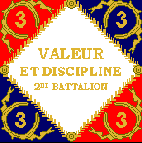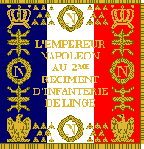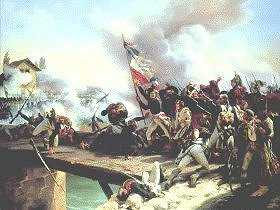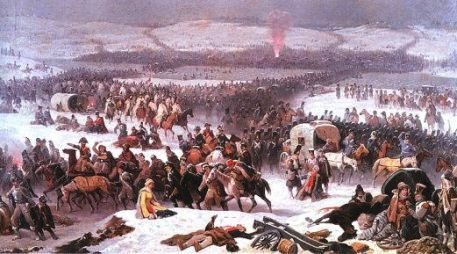.
"If the campaigns are studied,
the French certainly owes most of
their victories to her light infantry"
- Prussian general Schanhorst
|

The Best Regiments of Light Infantry.
War Record and Battle Honors (1804-1815).
 The French army contained many regiments of line (on picture) and light infantry whose soldierly skills and deeds
of daring reflected the unsurpassed devotion of the soldiers to their cause.
The 9th, 10th, 13th, 15th, 16th, 24th, 25th, 26th amd 27th - all won immortal fame in those ten
terrible years of strife.
The French army contained many regiments of line (on picture) and light infantry whose soldierly skills and deeds
of daring reflected the unsurpassed devotion of the soldiers to their cause.
The 9th, 10th, 13th, 15th, 16th, 24th, 25th, 26th amd 27th - all won immortal fame in those ten
terrible years of strife.
9e Regiment d'Infanterie Légère
4 Battle Honors : 1805 - Ulm, 1807 - Friedland, 1809 - Essling and Wagram.
29 Battles: 1805 - Ulm, Durrenstein, Vienne, Halle, Lubeck, 1806 - Waren, 1807 - Mohrengen, Eylau, Braunsberg, and Friedland, 1808 - Madrid, 1809 - Medellin and Talevera,
1809 - Essling and Wagram, 1811 - Chiclana and Fuentes-de-Onoro, 1812 - Badajoz and Bornos,
1813 - Vittoria, 1813 - Lutzen, Bautzen, Kulm, Peterswald, and Leipzig, 1814 - Toulouse and Santa-Maria de la Nieva, 1814 - Montmirail, 1815 - Ligny
Colonels: 1803 - Meunier, 1811 - Dauture, 1814 - Deslom, 1814 - Baume
10e Regiment d'Infanterie Légère
7 Battle Honors : 1805 - Ulm and Austerlitz, 1806 - Jena, 1807 - Eylau, 1809 - Eckmuhl, Essling and Wagram.
29 Battles: 1805 - Ulm and Austerlitz, 1806 - Jena, 1807 - Eylau, Heilsberg, and Friedland, 1809 - Thann, Landshut, Eckmuhl, Essling, and Wagram, 1812 - Alba, Carascal, and Estella, 1812 - Smoliany and Borisow, 1813 - Pampelune and Roncal, Lutzen, Kulm, Buntzlau, Naumbourg, Dresden, Leipzig, and Hanau, 1814 - Vauchamps, Bar-sur-Aube, and Arcis-sur-Aube, 1815 - Strasbourg
Colonels: 1803 - Pouzet, 1807 - Berthezene, 1811 - Luneau, 1815 - Creste
13e Regiment d'Infanterie Légère
5 Battle Honors 1805 - Austerlitz, 1806 - Jena, 1807 - Eylau, 1809 - Eckmuhl and Wagram 1809
17 Battles: 1805 - Austerlitz, 1806 - Auerstadt, 1807 - Landsberg and Eylau, 1809 - Rohr, Landshut, Ratisbonne, Dunaberg, and Wagram, 1812 - Smolensk, Borodino, Viasma, Krasnoe, and Beresina, 1813 - Dresden and Kulm, 1815 - Waterloo
Colonels: 1803 - Castex, 1805 - Guyardet, 1810 - Argence, 1812 - Quandalle, 1814 - Gougeon
15e Regiment d'Infanterie Légère
3 Battle Honors 1805 - Austerlitz, 1809 - Eckhmul and Wagram
27 Battles: 1805 - Amstetten and Austerlitz, 1807 - Koenigsberg, 1808 - Evora and Vimeiro
1809 - La Corogne and Misarella, 1809 - Donawerth, Thann, Landshut, Ratisbonne, Eckmuhl, and Wagram, 1810 - Cuidad Rodrigo, 1812 - Smolensk, Borodino, Mozhaisk, and Krasnoe, 1813 - Lauenbourg, Grosmulseau, and Hambourg, 1814 - Anvers, La Rothiere, and Monterau, 1815 - Ligny, Wavre, and Namur
Colonels: 1799 - Desailly, 1809 - Noos, 1813 - Brice
16e Regiment d'Infanterie Légère
5 Battle Honors: 1806 - Jena, 1807 - Eylau and Friedland, 1809 - Essling and Wagram
30 Battles: 1806 - Jena, 1807 - Eylau and Friedland, 1808 - Espinosa, Burgos, and Madrid,
1809 - Talevera, Essling and Wagram, 1810 - Ubrique, 1811 - Cadiz, Seguenza, Chiclana, Fuentes-d'Onoro, Albuhera, Bornos, and Tarifa, 1812 - Tarifa, 1813 - Col-de-Maya, Bidassoa, and Nive, 1813 - Lutzen, Wurschen, Dresden, Leipzig, and Dantzig, 1814 - Champaubert, Vauchamps, Reims, and Paris
Colonels: 1802 - Harispe, 1807 - Dellard, 1810 - Morio de l'Isle, 1813 - Cornebise
24e Regiment d'Infanterie Légère
6 Battle Honors: 1805 - Austerlitz, 1806 - Jena, 1807 - Eylau, 1809 - Eckmuhl, Essling and Wagram
23 Battles: 1805 - Austerlitz, 1807 - Bergfied, Eylau, Lomitten, Heilsberg, and Friedland, 1808 - Andujar, 1809 - Essling, Wagram, and Znaim, 1812 - Krasnoe, Smolensk, Valoutina and Borodino, 1813 - Bautzen, Dresden, and Leipzig, 1814 - Commercy, Brienne, La Rothiere, Monterau, Bar-sur-Aube, and Arcis-sur-Aube
Colonels: 1803 - Marion, 1810 - Pourailly, 1810 - Julienne de Belair, 1813 - Plazanet
25e Regiment d'Infanterie Légère
6 Battle Honors: 1805 - Ulm, 1806 - Jena, 1807 - Eylau and Friedland, 1809 - Essling and Wagram
24 Battles: 1805 - Gunzberg and Scharnitz, 1806 - Jena, 1807 - Allenstein, Guttstadt, and Friedland, 1808 - Saragosse and Cascantes, 1809 - Tamammes, 1809 - Essling and Wagram,
1810 - Cuidad Rodrigo and Alcoba, 1811 - Redhina, Foz-do-Aronce, and Miranda-del-Corvo,
1812 - Arapiles, 1813 - Lerin and Muz, 1813 - Lutzen, Wurschen, Buntzlau, and Leipzig,
1814 - Toulouse
Colonels: 1804 - Morel, 1807 - Anselme, 1810 - De Conchy, 1813 - Creste
26e Regiment d'Infanterie Légère
7 Battle Honors: 1805 - Ulm and Austerlitz, 1806 - Jena, 1807 - Eylau, 1809 - Eckmuhl, Essling and Wagram
27 Battles: 1805 - Ulm and Austerlitz, 1807 - Hoff, Eylau, Heilsberg, and Konigsberg
1808 - Saragosse, Andujar, and Baylen (there they SURRENDERED to the Spaniards), 1809 - Eckmuhl, Ebersberg, Essling, Wagram, Hollabrun, and Znaim, 1812 - Oboiardszino, Polotsk, Torezacew, Borisow, and Beresina, 1813 - Hambourg, Dresden, Leipzig, Freibourg, and Hanau, 1814 - Ligny and Brienne
Colonels: 1802 - Baciocchi, 1805 - Pouget (he was one of THE BEST and was killed at Wagram), 1809 - Campi, 1810 - Gueheneuc, 1813 - Mosnier, 1813 - Crepy, 1813 - Dornier, 1814 - Limonzin
27e Regiment d'Infanterie Légère
5 Battle Honors: 1805 - Austerlitz, 1806 - Jena, 1807 - Friedland, 1809 - Essling and Wagram
34 Battles: 1805 - Ulm and Austerlitz, 1806 - Scheltz, Halle, and Lubeck, 1807 - Mohrungen and Friedland, 1808 - Madrid, Durango, Valmesada, Sandupe, and Espinosa,
1809 - Essling and Wagram, 1809 - Talevera, 1810 - Medina-Sidona and Celerico,
1811 - Chiclana and Fuentes-d'Onoro, 1813 - Wurschen, Gieshubel, Dresden, Grieffenberg, Elsen, Dohna, Bautzen, and Dantzig, 1813 - Col de Maya, Pampelune, Bidassoa, Spelleto, and Bayonne,
1814 - Lille and Courtrai
Colonels: 1804 - Charnotet, 1807 - Lacoste, 1813 - Deschamps
|




 "The army's infantry is its most essential component. Even today, no army can take and hold any ground without
the use of infantry." (Nafziger - "Napoleon's Invasion of Russia" p 13, 1998)
The infantry was the basis of the Napoleonic army, which was the largest army in the World in that time.
Such army was necessary as France had several powerfull enemies on land; Russia, Prussia and
Austria all had large armies. In this situation accepting only volunteers (as it was in the small Swiss and
British armies) was not enough. To meet the numbers
"The army's infantry is its most essential component. Even today, no army can take and hold any ground without
the use of infantry." (Nafziger - "Napoleon's Invasion of Russia" p 13, 1998)
The infantry was the basis of the Napoleonic army, which was the largest army in the World in that time.
Such army was necessary as France had several powerfull enemies on land; Russia, Prussia and
Austria all had large armies. In this situation accepting only volunteers (as it was in the small Swiss and
British armies) was not enough. To meet the numbers
 In 1803-1807 France had probably the best infantry which had ever existed in Europe up until
that time. It was the Camp of Boulogne that Napoleon's greatest military ideas were executed.
The Napoleonic foot soldiers were known for agility, stubborn attacks, and the speed of their marches.
Maneuverability and speed were the characterictics of Napoleon's lightning campaigns.
The infantry performed some extraordinary marches, for example in 1805 and in 1808
during the pursuit of the fleeing British troops.
Chlapowski writes: "The arrival of the first French infantry division [to Poland], belonging to Davout's Corps, made
a strange impression on me. A dozen or so of us rode out to meet it, and about a mile outside the city we saw fields completely covered with individual soldiers, in greatcoats
of every color, carrying their muskets with the butts in the air and picking dry paths through the fields
to avoid the knee-deep mud on the road. Right outside the city [Posen], by the windmills, there was a beating of drums,
and they all came running to form ranks and in the blinking of an eye they had taken off their greatcoats, straightened
their bicornes on their heads and become the most regular armies. They then marched at a lively pace into the city with bands playing. They halted in the market square, stacked their weapons and took out little
brushes to wipe the mud from their shoes and began fooling around as if they had only been marching for a mile, not the 150 miles they had just completed.
I stared in amazement at these boisterous infantrymen, so far undefeated. They might as well have been going to a dance.
In 1803-1807 France had probably the best infantry which had ever existed in Europe up until
that time. It was the Camp of Boulogne that Napoleon's greatest military ideas were executed.
The Napoleonic foot soldiers were known for agility, stubborn attacks, and the speed of their marches.
Maneuverability and speed were the characterictics of Napoleon's lightning campaigns.
The infantry performed some extraordinary marches, for example in 1805 and in 1808
during the pursuit of the fleeing British troops.
Chlapowski writes: "The arrival of the first French infantry division [to Poland], belonging to Davout's Corps, made
a strange impression on me. A dozen or so of us rode out to meet it, and about a mile outside the city we saw fields completely covered with individual soldiers, in greatcoats
of every color, carrying their muskets with the butts in the air and picking dry paths through the fields
to avoid the knee-deep mud on the road. Right outside the city [Posen], by the windmills, there was a beating of drums,
and they all came running to form ranks and in the blinking of an eye they had taken off their greatcoats, straightened
their bicornes on their heads and become the most regular armies. They then marched at a lively pace into the city with bands playing. They halted in the market square, stacked their weapons and took out little
brushes to wipe the mud from their shoes and began fooling around as if they had only been marching for a mile, not the 150 miles they had just completed.
I stared in amazement at these boisterous infantrymen, so far undefeated. They might as well have been going to a dance.
 On picture: "the French arrived [at Tordesillas], 60
... headed by Cpt Guingret, a daring man,
formed a small raft to hold their arms and clothes, and plunged into the water, holding their swords with their teeth,
swimming and pushing their raft before them. Under protection of a cannonande they crossed this
great river, though it was in full and strong water, and the weather very cold, and having reached the other side,
naked as they were, stormed the tower: the Brunswick regiment then abandoned the wood, and the gallant Frenchmen
remained masters of the bridge." (Napier - "History of the War ..."
Vol IV, p 138)
On picture: "the French arrived [at Tordesillas], 60
... headed by Cpt Guingret, a daring man,
formed a small raft to hold their arms and clothes, and plunged into the water, holding their swords with their teeth,
swimming and pushing their raft before them. Under protection of a cannonande they crossed this
great river, though it was in full and strong water, and the weather very cold, and having reached the other side,
naked as they were, stormed the tower: the Brunswick regiment then abandoned the wood, and the gallant Frenchmen
remained masters of the bridge." (Napier - "History of the War ..."
Vol IV, p 138) In 1812 the majority of veterans was swallowed up in the bloody battles and the snows of Russia. The casualties were horrible and it required a heart of stone to look on
In 1812 the majority of veterans was swallowed up in the bloody battles and the snows of Russia. The casualties were horrible and it required a heart of stone to look on  There were two types of infantry, line and light. Both were able to execute all maneuvers, incl. skirmishing. The light infantryman however was more intensively trained in marksmanship and in executing all maneuvers in higher speed. The light infantry formed advance guards and scouting parties. This kind of service had fostered the soldier's intelligence and independent judgement. No longer he was a mindless robot in a lock-step formation, moving and firing only upon order.
There were two types of infantry, line and light. Both were able to execute all maneuvers, incl. skirmishing. The light infantryman however was more intensively trained in marksmanship and in executing all maneuvers in higher speed. The light infantry formed advance guards and scouting parties. This kind of service had fostered the soldier's intelligence and independent judgement. No longer he was a mindless robot in a lock-step formation, moving and firing only upon order.
 Philippe-Guillaume Duhesme (1766-1815).
Philippe-Guillaume Duhesme (1766-1815). "He was a brutal and violent soldier, renowned for insubordination and looting. Napoleon once said to him,
'If I had two of you, the only solution would be to have one hang the other.' He also said that were he,
Napoleon, to launch a campaign against Lucifer in Hell, then he would give Vandamme command of the vanguard." (wikipedia.org 2005)
"He was a brutal and violent soldier, renowned for insubordination and looting. Napoleon once said to him,
'If I had two of you, the only solution would be to have one hang the other.' He also said that were he,
Napoleon, to launch a campaign against Lucifer in Hell, then he would give Vandamme command of the vanguard." (wikipedia.org 2005)
 Compans began his military career in 1791 in the volunteers of Haute-Garonne and became captain at the of 23.
Compans met Bonaparte during the siege of Toulon. He was promoted to the rank of general of brigade in 1799.
In 1806 Compans became general of division and served in Davout's corps for several years. In 1812 during the Invasion of Russia,
Compans commanded 5th Infantry Division in Davout's I Army Corps. (In 5th Division was the famous 57th Line Regiment, nicknamed
"The Terrible" for bravery in combat.)
Compans began his military career in 1791 in the volunteers of Haute-Garonne and became captain at the of 23.
Compans met Bonaparte during the siege of Toulon. He was promoted to the rank of general of brigade in 1799.
In 1806 Compans became general of division and served in Davout's corps for several years. In 1812 during the Invasion of Russia,
Compans commanded 5th Infantry Division in Davout's I Army Corps. (In 5th Division was the famous 57th Line Regiment, nicknamed
"The Terrible" for bravery in combat.)  On picture: Voltigeur of Line Infantry, 1812 Musee de l'Armee, France.
Napoleonic infantryman was armed with 'Charleville' musket model 1777 (AN IX), with overall length 151.5 cm, (barrel length 114 cm) and a triangular bayonet 45.6 cm.
On picture: Voltigeur of Line Infantry, 1812 Musee de l'Armee, France.
Napoleonic infantryman was armed with 'Charleville' musket model 1777 (AN IX), with overall length 151.5 cm, (barrel length 114 cm) and a triangular bayonet 45.6 cm.
 On picture: French
On picture: French 

 Just as modern company commander relies on his radio operator, his Napoleonic counterpart
depended on his drummers and cornets. During a battle it was very noisy and not everyone could hear
a officer's voice. For this reason every company had drummers and cornets.
They also performed a service that went beyond supplying a rhythmic musical accompaniment to the
marching infantry. The musicians carried wounded officers out of danger zone and after battle
stacking their drums, they would await the grim task of carrying their stricken comrades to field
hospitals.
Just as modern company commander relies on his radio operator, his Napoleonic counterpart
depended on his drummers and cornets. During a battle it was very noisy and not everyone could hear
a officer's voice. For this reason every company had drummers and cornets.
They also performed a service that went beyond supplying a rhythmic musical accompaniment to the
marching infantry. The musicians carried wounded officers out of danger zone and after battle
stacking their drums, they would await the grim task of carrying their stricken comrades to field
hospitals.
 Each field battalion had only one grenadier company (carabinier in light infantry). They were the elite shock troop often used as spearhead of attacking force. They were also granted a higher pay.
The Prussian King Frederick the Great, required from his grenadiers to be brave, good marchers, with black hair and moustaches, not appear too amiable or laugh too easily and not have an effeminate aspects. He formed them in battalions and used as crack troops on battlefield.
Each field battalion had only one grenadier company (carabinier in light infantry). They were the elite shock troop often used as spearhead of attacking force. They were also granted a higher pay.
The Prussian King Frederick the Great, required from his grenadiers to be brave, good marchers, with black hair and moustaches, not appear too amiable or laugh too easily and not have an effeminate aspects. He formed them in battalions and used as crack troops on battlefield.
 Each field battalion had only 1 grenadier and 1 voltigeur company, the remaining 4-8 companies were made of fusiliers (chasseurs in light infantry). Until 1805 there were 8 fusilier companies per battalion, between 1805 and 1807 were seven and in 1808-1815 only four per battalion. The fusiliers (chasseurs in light infantry) occupied the center of battalion line.
Each field battalion had only 1 grenadier and 1 voltigeur company, the remaining 4-8 companies were made of fusiliers (chasseurs in light infantry). Until 1805 there were 8 fusilier companies per battalion, between 1805 and 1807 were seven and in 1808-1815 only four per battalion. The fusiliers (chasseurs in light infantry) occupied the center of battalion line.


 The flag of 1815 was also a tri-color pattern but it lacked almost all the magnificent embroidery of 1804 pattern. After Waterloo the Bourbons did their best to see that all the napoleonic standards and eagles were destroyed. In some regiments the officers burned the standards before mixing the ashes with wine and drinking them down. The officers of the 2nd Swiss Regiment in napoleonic army, tore their standard into strips with each officer keeping a piece.
The flag of 1815 was also a tri-color pattern but it lacked almost all the magnificent embroidery of 1804 pattern. After Waterloo the Bourbons did their best to see that all the napoleonic standards and eagles were destroyed. In some regiments the officers burned the standards before mixing the ashes with wine and drinking them down. The officers of the 2nd Swiss Regiment in napoleonic army, tore their standard into strips with each officer keeping a piece.
 The French army contained many regiments of line (on picture) and light infantry whose soldierly skills and deeds
of daring reflected the unsurpassed devotion of the soldiers to their cause.
The 9th, 10th, 13th, 15th, 16th, 24th, 25th, 26th amd 27th - all won immortal fame in those ten
terrible years of strife.
The French army contained many regiments of line (on picture) and light infantry whose soldierly skills and deeds
of daring reflected the unsurpassed devotion of the soldiers to their cause.
The 9th, 10th, 13th, 15th, 16th, 24th, 25th, 26th amd 27th - all won immortal fame in those ten
terrible years of strife.